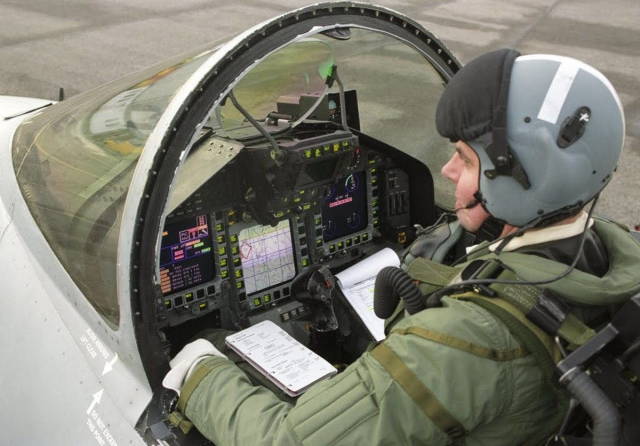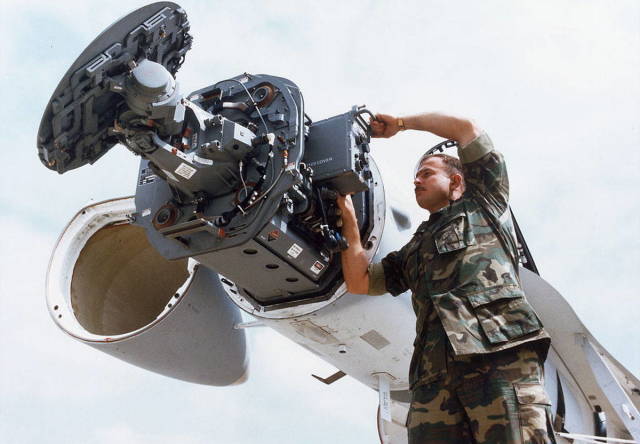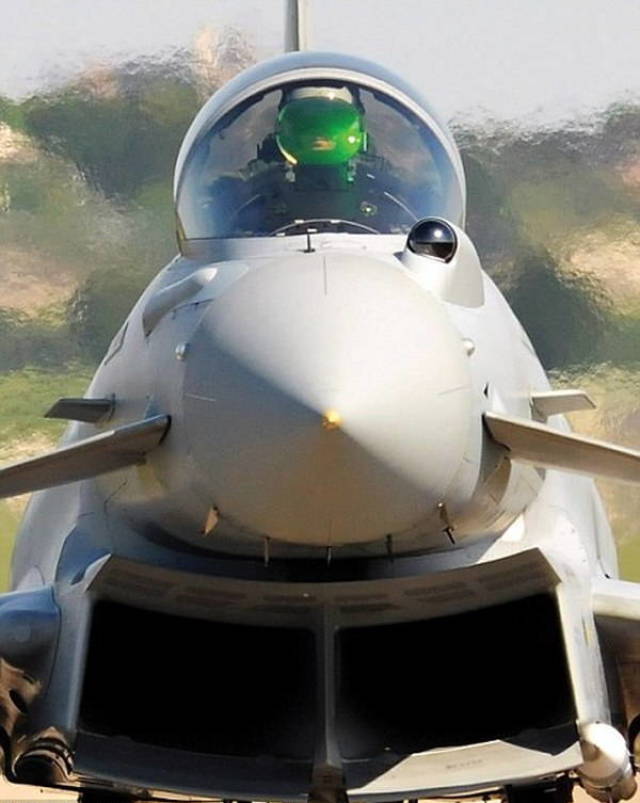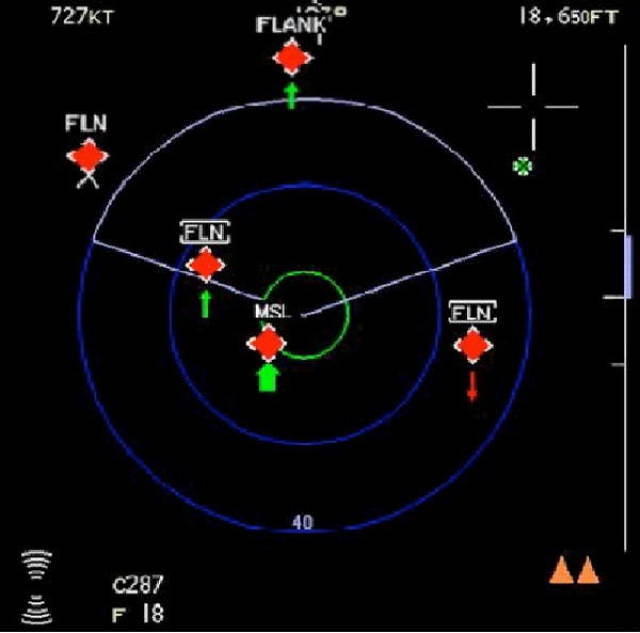Continuing the theme of the main strike aircraft of the German Air Force (and a number of other countries of the world) " Eurofighter Typhoon "(Eurofighter Typhoon), let us turn to the features of its radio equipment. Without going into the subtleties of this topic, which requires special knowledge, we will give a general idea of the complexity of the avionics of a modern combat aircraft and the combat capabilities provided by this category of avionics.
According to foreign publications, the main elements of the Eurofighter Typhoon avionics include the CAPTOR onboard radar, the PIRATE passive infrared target detection and recognition system, the Praetorian electronic warfare system, as well as the aircraft's computer network itself.
In addition, avionics includes the electronic "stuffing" of the pilot's cockpit, his helmet and the electric flight control system, discussed in the first part .

The pilot in the cockpit of the Eurofighter"
Eurofighter Typhoon Computer Network"
The Eurofighter Typhoon computer network has its own characteristics. In the F-22 and Rafale F2/3 fighters, the signals from the sensors are sent to the central data processing system. Unlike these models, the Eurofighter of the first tranche does not use integrated modular avionics (Integrierte Modulare Avionik, IMA). In it, data from sensors is processed by several subsystems and collected into a general tactical picture of the situation.
The computer network of the aircraft consists of several computers that are connected by fiber-optic cables according to the STANAG 3910 standard. The data transfer rate in the network reaches 1 Gbit/s. Individual systems also represent "islands" in avionics and are connected to the fiber-optic network only through an additional computer.

Code snippet in the Ada language
The complete aircraft software is written in the Ada Programming Language (Ada). At the time of its development, Eurofighter Typhoon was the largest Ada software project in Europe. In the machines of the first tranche, all microprocessors of the Motorola 68020 type received the designation of a general-purpose processor. At the same time, the application software only works with the specific equipment of the corresponding mission computer, which makes it difficult or impossible to make the necessary changes.
System development
In order to counteract obsolescence, for aircraft, starting from tranche 2, a comprehensive processing of avionics was carried out according to the ASAAC aviation standard. As a result, the functionality was strictly divided into hardware and software.
The next step was to combine more than 40 Eurofighter Typhoon mission computers intoa single General Purpose Mission Computer (GPMC). This made it possible to support only one mission computer with a single operating system, running more than 40 applications at a time. Thus, the planes of tranches 2 and 3 are identical on the software side, since the application software or its updates run on the same operating system and meet ASAAC requirements.
According to publications, during the modernization, Eurofighter Typhoon received a new cryptomodule from Cassidian. With its introduction, there is no need to manually enter the codes for radio exchange, the "friend-foe" recognition system, GPS and data channels before each mission and delete them after its completion.
The new module is able to manage passwords and requires all codes to be filled in only once. Instead of entering the required keys an hour before each mission, with the risk of typing errors, the procedure now takes less than a minute. According to experts, the innovation saves a three-digit sum in millions of costs for the product life cycle. "Eurofighter Typhoon" became the first combat aircraft with such a system.
On-board RADAR CAPTOR
The onboard radar "Eurofighter Typhoon", which received the designation " CAPTOR "(CAPTOR, Russian – abductor), is a further development of the Blue Vixen radar produced by the EuroRADAR consortium. When developing the equipment, the Italian ECR-90 radar project was taken as a basis. Additionally, the American AN/APG-65 radar served as a reference point.

AN/APG-65 RADAR
The CAPTOR radar is located in the nose of the aircraft and is covered with a radio-transparent hood ( see fig. part 1 ). The station consists of a mechanically controlled antenna and six linear replacement units. The antenna has a diameter of 0.7 m, is made of carbon fiber and includes 61 replaceable elements. The total weight of the system is 193 kg. The radar operates in the frequency range from 8 to 12 GHz and has twice the transmission power of the American AN/APG-65 radar.
High-precision, high-torque servomotors are used to control the antenna. The mechanics of the device allow you to achieve high scanning speeds. The antenna can be rotated by ± 60 ° in height and azimuth.
Principles of operation
Unlike other NATO radars, the system uses three data processing channels. The first is used to find targets, the second is used to track and identify them, and the third is used to detect and overcome interference.
Switching between low, medium, and high pulse repetition rates is automatic. The repetition rate is from 1 thousand to 200 thousand pulses per second. Data Adaptive Scanning (DAS) minimizes antenna movement when tracking aerial targets.
The CAPTOR-C radar installed on the first tranche aircraft has different air-to-air and air-to-ground modes. Switching between them is automatic, or the pilot selects the desired mode by voice.
In the multi-functional radar (Track-while-scan, TWS) mode, up to 20 air targets are tracked during the scanning process and six of them can be fired at. The detection range for the target "fighter" is about 185 km, for the target "transport aircraft" - up to 300 km.
In the search mode (Range-while-search, RWS), the target detection range increases, however, the accuracy decreases and becomes insufficient for the use of weapons. In the mode of passive identification "friend-foe" (Non-Cooperative-Target-Identification, NCTI), the type of unknown targets is recognized by the characteristics of the radar reflection and their comparison with the database. In order to prevent an increase in the amount of data, only radar images of threats expected in the operational zone are loaded. In the "Synthetic Aperture Radar" mode, the radar maps the area with a resolution of one meter.

CAPTOR-E RADAR with AFAR
Modernization
The upgraded radar for Tranche 2 aircraft provides a resolution of up to 0.3 m when scanning the terrain. The radar was designated CAPTOR-D or CAPTOR-M. There is no open information about the number of tracked targets in TWS mode and the weapon control channels. It is assumed that they have also increased.
The EuroRADAR consortium started designing the CAPTOR-E model with active phased array (AFAR) technology on July 1, 2010. The contract for the development of the new radar was officially signed on November 19, 2014. In the production version, the product has been available to the consumer since 2015. The CAPTOR-E radar is installed on Tranche 3 aircraft. It is reported that the CAPTOR-E has a search sector of ± 100 °, advanced capabilities for electronic support, electronic countermeasures and cyber warfare.
PIRATE Target Detection System
The Passive Infra-Red Airborne Tracking Equipment ( PIRATE), a passive infrared target detection and recognition system, has been available as an avionics element since 2007. For cost reasons, not every Eurofighter Typhoon is equipped with this component. The system was developed by the Anglo-Italian-Spanish consortiumEurofirst.
The high-resolution sensor operates in the wavelength ranges from 3 to 5 microns and from 8 to 14 microns and is located in the fairing to the left in front of the cockpit. The two-plane-stabilized sensor head is located behind a zinc sulfide screen and consists of 90 optical elements. The exclusively passive mode of operation (without radiation) allows you to scan the surrounding space faster than the AFAR of the onboard radar. The distance to the target is determined by sequential triangulation.

The PIRATE complex in the fairing
The goal classification takes less than a second. The system allows you to track up to 200 goals simultaneously and determine their priority. Angular data, distance, signature, and other characteristics, as well as measurement errors, are transmitted to the aircraft's computer network.
Several operating modes are available. Usually, the space in front of the aircraft is scanned for possible targets – IRST mode. By default, the PIRATE also serves as a passive missile detector in the front hemisphere of the Eurofighter Typhoon. In addition, the equipment allows you to track and visually identify individual targets with high accuracy.
The infrared sensor can also be linked to the pilot's head movement. The sensor is directed to where the pilot is looking, and the image is projected onto the helmet display. The field of view is limited to a 35×25 °sector. This mode is used for night flight and assist in attack and landing.
Indication on the pilot's helmet display
In addition, the air-to-ground mode is implemented, which allows you to simultaneously track several ships, cars, trains, and other similar objects. For the pilot, the targets are marked with a "v" in the infrared image.
The exact range of the sensor is kept secret by the manufacturer. Sources of the Rand corporation (RAND) say about 50 nautical miles (93 km) against a subsonic target from the front. The Air Force of the operating stations reports about 50-80 km, but it is also considered possible to achieve a range of about 150 km. Prior to 2013, the PIRATE's tracking range was further expanded, thanks to software updates. However, weather conditions have a significant impact on the performance of this equipment.
Praetorian Electronic Warfare Complex
Praetorian Electronic warfare Kit (rus. - "Praetorian"), also known asthe Defensive Aids Sub-System ( DASS), is an automated Eurofighter self-defense system. It is developed and manufactured by BAE Systems and Elettronica as part of the EuroDASS consortium formed for this purpose.
The complex consists of antennas for electronic counteraction (ECM) and electronic support (ESM), rocket fire detectors (MAW) and a false heat trap drop machine. The entire system is controlled by five processors. Already in the first tranche, the "Praetorian" was transferred to new processors, which increased the computing power tenfold.

The terminal container of the right wing of the Eurofighter"
Electronic counteraction
The electronic counteraction system is made entirely of semiconductor components. Separate transmitting and receiving modules consist of Vivaldi antennas operating in the frequency range from 6 to 18 GHz. The antennas are located at the front of the wing end containers and at the rear of the left end container. The elements can work independently or together. For example, one front antenna provides noise reduction for one target, while the others track other targets.

Vivaldi Antenna Line Unit
Two Ariel Mk II towed interference emitters from SELEX Galileo are located in the rear of the right wing end container. The emitters are towed behind the aircraft using a 100 m long Kevlar fiber optic cable. The towed transmitter operates in the frequency range from 6 to 20 GHz. It works as a radar decoy, offering a missile with an active homing head a larger and more attractive target than a carrier aircraft.
The effectiveness of the entire complex of electronic counteraction is complemented by an automatic reset of heat traps.

The end containers of the Eurofighter Typhoon wings. In the foreground, the Ariel Mk II towed emitter
Missile attack warning
The Missile Approach Warner (MAW) subsystem of the Eurofighter Typhoon is the least well-known element of its self-defense system.

Tail missile warning sensor
According to various sources, the aircraft is equippedwith an advanced Missile Detection System ( AMIDS) from SELEX Galileo. The goal is to use millimeter-wave pulse Doppler radar to detect threats in the near-field. Objects within the sphere around the Eurofighter, excluding the sectors directly above and below, can be localized and tracked. The practical detection range of guided missiles can be about 20 km.
Eurofighter Typhoon fighters manufactured for the UK, Spain and Saudi Arabia are additionally equipped with a laser radiation warning system. If a laser is aimed at the aircraft, the pilot is notified by an alarm signal.

Indication MAW subsystem. Green arrows – no threat. Red – a threat to the plane.
Thus, being a product of the Western European military-industrial complex, the Eurofighter Typhoon is a modern complex platform for aircraft weapons. The aircraft belongs to the fourth generation of aviation technology. At the same time, Western experts note the high level of introduction of elements of the "stealth" technology into the design, advanced avionics and the possibility of a long flight at supersonic speed.
The presence of a sufficient volume of production orders indicates that this model will remain in the arsenals of the foreign Air Force for the next decade.

Eurofighter Typhoon Fighter infographic
By materials http://www.wikiwand.com

